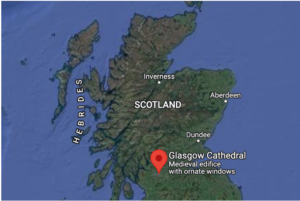
Glasgow (or St Mungo’s) Cathedral is situated at the heart of Scotland’s largest city. It is the most complete medieval cathedral still to survive on the Scottish mainland, and the most important building of its period surviving in Scotland. Dedicated to St Mungo or Kentigern (the patron saint and founder of the city of Glasgow), the present building originated in the 12th century, but much of what stands today dates from a major rebuilding in the 13th century.

Glasgow Cathedral
The cathedral continued in use for parochial worship after the Protestant Reformation of 1560. Three separate congregations came to worship in it, resulting in changes to the interior of the building over the next 250 years. By 1835, two of those congregations had moved elsewhere in the city, enabling a restoration of the cathedral to its former glory. In 1857 the entire building passed into State care, but it remains very much in ecclesiastical use as a parish church within the Church of Scotland, as well as playing an important role in wider civic and national life.
Many of the modifications to the interior in the 18th and 19th century were dedicated to wealthy patrons to the church. In many cases, these were families associated with the tobacco and sugar trades in Glasgow – trades that were built largely on the enslavement of human beings and their labour. Glasgow Cathedral therefore serves as a reminder of the personal and economic involvement of Scotland’s landed and mercantile class in the transatlantic Slave trade during this period.
Links to the transatlantic slave trade through patrons of the church
Amongst the many families who donated funds to the church, there are memorials to William Stirling of Keir, Alexander Spiers of Elderslie and Richard Oswald of Auchincruive. These memorials to prominent families living in 19th century Glasgow show the large economic incomes that influential Scots families had during this period. It is clear from this research that much of the money held by these families was through their involvement in the transatlantic slave economy during the 18th and early 19th centuries. This money was obtained by members of these families acting as enslavers on plantations in the West Indies, through mercantile links with tobacco, sugar and other goods associated with the transatlantic slave economy, and in the case of the Oswalds of Auchincruive, through the business of the transatlantic slave trade.
When looking at the wider estates of the families commemorated within the cathedral, it is clear that money was also being invested by these families in the expansion of Glasgow as an urban hub, the development of Scottish industries, and the construction of stately homes and associated estates on the West Coast of Scotland. This shows that there are direct links between the money made through Imperial colonisation and the enslavement of African people, and the growth of the industrial, urban and rural landscapes of Scotland.
While 3 prominent families have been mentioned above, there are numerous memorials to other families both inside of Glasgow Cathedral, and within the cathedral grounds. It is likely that further research on the families commemorated on lesser known memorials and their wider estates will uncover further links between the money made through the transatlantic slave economy, and investment in Scottish built environment during the 18th, 19th and 20th centuries.
Acknowledgements
This information was collated through research carried out by CRER, HES, and the UCL Legacies of British slave-ownership database.
Image Attributes:
Image 1:- Map courtesy of google.com
Image2:- Glasgow Cathedral (Creative Commons)